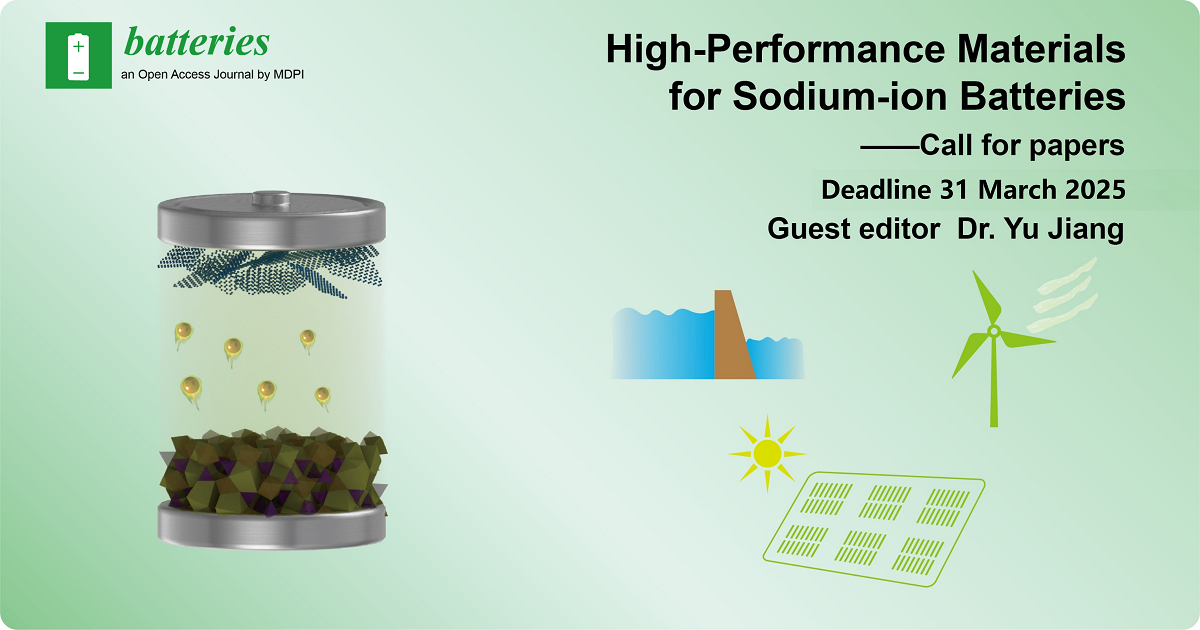High-Performance Materials for Sodium-Ion Batteries: 2nd Edition
A special issue of Batteries (ISSN 2313-0105). This special issue belongs to the section "Battery Materials and Interfaces: Anode, Cathode, Separators and Electrolytes or Others".
Deadline for manuscript submissions: 31 March 2025 | Viewed by 960

Special Issue Editor
Interests: design of novel nanomaterials for clean energy for batteries and the fundamental science of energy storage systems
Special Issues, Collections and Topics in MDPI journals
Special Issue Information
Dear Colleagues,
Sodium-ion batteries (NIBs) are an attractive alternative due to the abundance of their components in the earth and the low cost of sodium. Therefore, this Special Issue is designed to focus on updating the field of energy storage with the latest advances and prospects regarding various aspects of NIBs. Researchers are invited to submit their original research and review/perspective articles for publication in this Special Issue.
Topics of interest include, but are not limited to, the following:
- Various types of NIBs: metal oxides, polyanionic compounds, Prussian blue (PB), organic cathodes, Na-S, Na-O2;
- Design strategies of electrodes, electrolytes, and separators for NIBs;
- Solid electrolyte interphase (SEI);
- Cathode/electrolyte interphase (CEI);
- NIBs for low/high-temperature conditions;
- Battery life and safety;
- Flexible NIBs;
- Solid-state NIBs;
- NIBs for electric vehicles.
Dr. Yu Jiang
Guest Editor
Manuscript Submission Information
Manuscripts should be submitted online at www.mdpi.com by registering and logging in to this website. Once you are registered, click here to go to the submission form. Manuscripts can be submitted until the deadline. All submissions that pass pre-check are peer-reviewed. Accepted papers will be published continuously in the journal (as soon as accepted) and will be listed together on the special issue website. Research articles, review articles as well as short communications are invited. For planned papers, a title and short abstract (about 100 words) can be sent to the Editorial Office for announcement on this website.
Submitted manuscripts should not have been published previously, nor be under consideration for publication elsewhere (except conference proceedings papers). All manuscripts are thoroughly refereed through a single-blind peer-review process. A guide for authors and other relevant information for submission of manuscripts is available on the Instructions for Authors page. Batteries is an international peer-reviewed open access monthly journal published by MDPI.
Please visit the Instructions for Authors page before submitting a manuscript. The Article Processing Charge (APC) for publication in this open access journal is 2700 CHF (Swiss Francs). Submitted papers should be well formatted and use good English. Authors may use MDPI's English editing service prior to publication or during author revisions.
Keywords
- NIBs
- Na-metal batteries
- Na-S
- Na-O2 design strategies of electrodes
- electrolytes and separators
- solid electrolyte interphase (SEI)
- cathode/electrolyte interphase (CEI)
- low/high-temperature performance
- battery life and safety
- flexible NIBs
- solid-state NIBs
- electric vehicles
Benefits of Publishing in a Special Issue
- Ease of navigation: Grouping papers by topic helps scholars navigate broad scope journals more efficiently.
- Greater discoverability: Special Issues support the reach and impact of scientific research. Articles in Special Issues are more discoverable and cited more frequently.
- Expansion of research network: Special Issues facilitate connections among authors, fostering scientific collaborations.
- External promotion: Articles in Special Issues are often promoted through the journal's social media, increasing their visibility.
- e-Book format: Special Issues with more than 10 articles can be published as dedicated e-books, ensuring wide and rapid dissemination.
Further information on MDPI's Special Issue polices can be found here.
Related Special Issue
- High-Performance Materials for Sodium-Ion Batteries in Batteries (7 articles)





